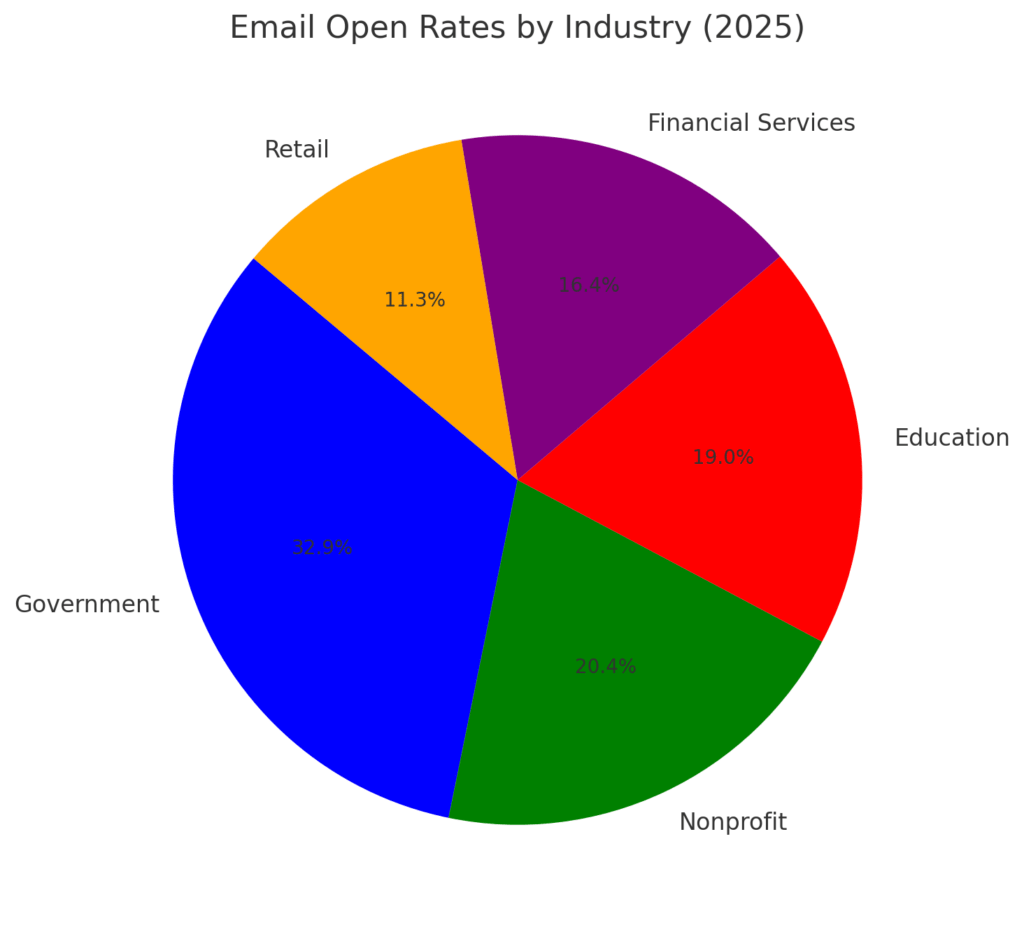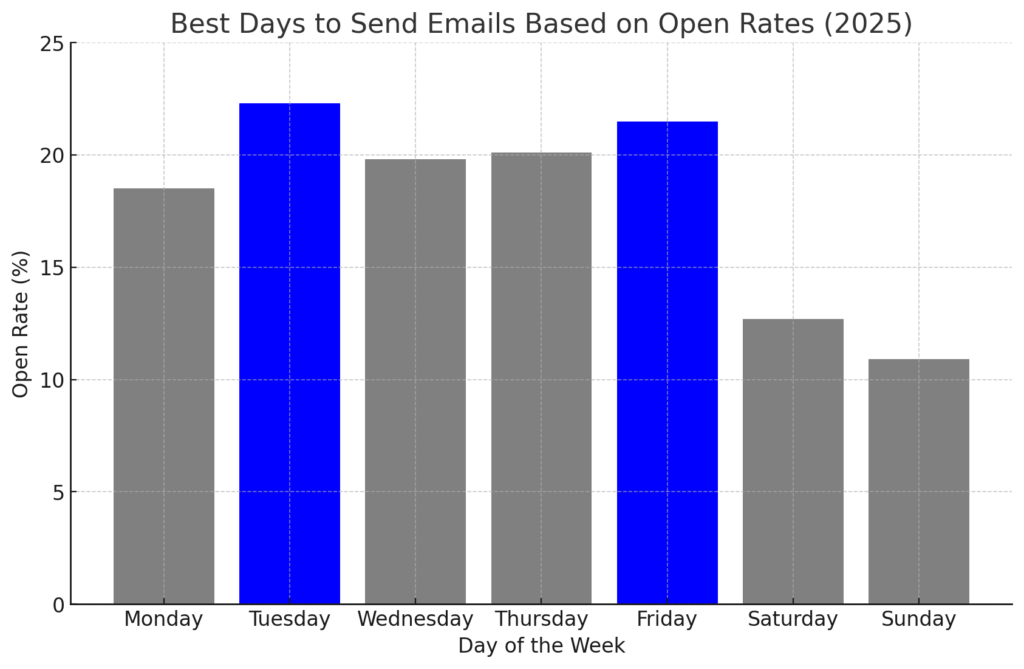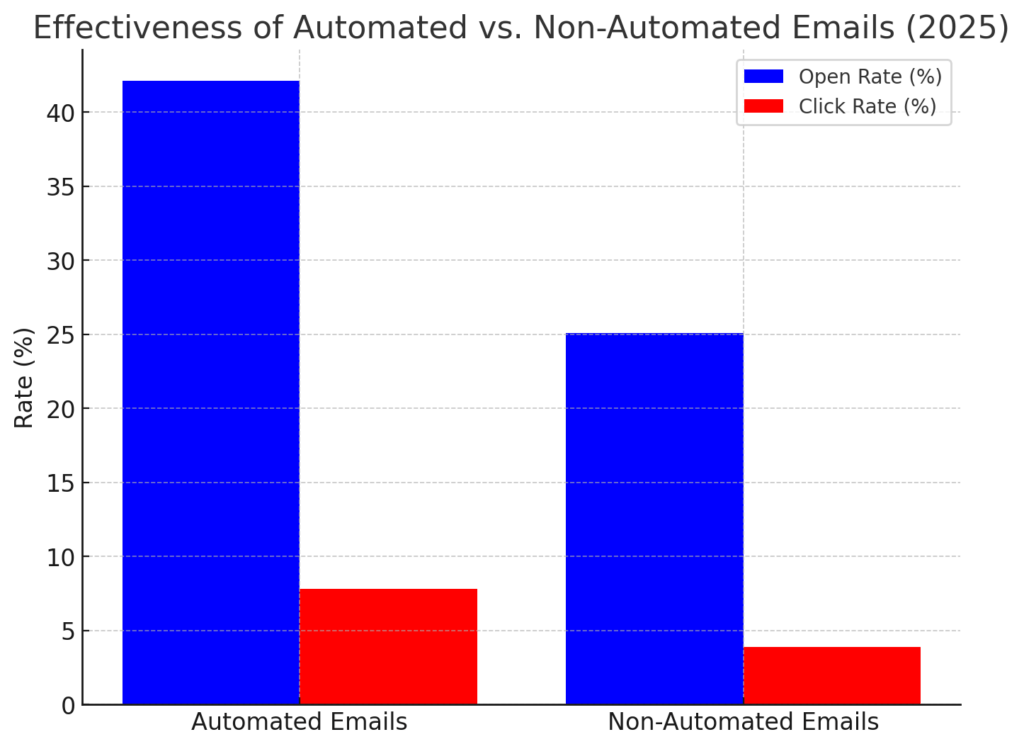
09 Mar BEST EMAIL OPEN RATE STATISTICS 2025
Email marketing remains one of the most effective digital communication channels, but success depends on understanding key performance benchmarks. Open rates, a primary indicator of engagement, provide valuable insights into what works and what doesn’t. In 2025, evolving consumer behaviors, AI-driven personalization, and new email technologies are reshaping how businesses connect with their audiences. Industry trends show that elements like subject line personalization, timing, and automation can significantly impact whether an email gets opened or ignored. Mobile optimization is also more critical than ever, with a growing number of users checking emails on their phones. As brands navigate these shifts, staying informed about the latest open rate statistics will be essential for optimizing campaigns. Below, Amra and Elma lists ten of the most important email open rate statistics, along with their long-term implications.
BEST EMAIL OPEN RATE STATISTICS 2025 (Editor’s Choice)
Understanding email open rate statistics is crucial for evaluating the effectiveness of your email marketing campaigns. Below are ten key insights, including general trends over time and specific benchmarks for 2025, sourced from reputable industry reports:
1. Overall Average Open Rate: As of 2025, the average open rate for email marketing campaigns stands at 25.10%.
2. Industry-Specific Open Rates:
- Nonprofits: Nonprofit organizations have an average open rate of 40.04%.
- Education and Training: This sector sees an average open rate of 35.64%.
- Business and Finance: Companies in this industry experience an average open rate of 31.35%.
3. Impact of Subject Lines: Emails with personalized subject lines, such as including the recipient’s name, have an open rate of 18.30%, compared to 15.70% for those without personalization.
4. Effect of Emojis: Including emojis in subject lines can increase open rates by 56% compared to text-only subject lines.
5. Welcome Emails: Welcome emails have a notably high open rate, averaging 54.3% in the ecommerce sector.
6. Mobile Optimization: With 59% of Millennials primarily using their cellphones to check email, optimizing emails for mobile devices is essential to maintain and improve open rates.
7. Timing of Opens: Email campaigns see the highest open rates shortly after they are sent, with 21.2% of all email opens occurring within the first hour.
8. Day of the Week: The best days to send emails to achieve higher open rates are Tuesdays and Fridays.
9. Automation Advantage: Automated email campaigns achieve an average open rate of 42.1%, highlighting the effectiveness of automation in engaging subscribers.
10. Global Trends: Email marketers in North America have seen open rates increase by 14.2% from the previous year, reaching 45.3%.
These statistics underscore the importance of personalization, timing, mobile optimization, and automation in enhancing email open rates. By aligning your strategies with these insights, you can improve the performance of your email marketing campaigns.

BEST EMAIL OPEN RATE STATISTICS 2025 and Future Implications
BEST EMAIL OPEN RATE STATISTICS 2025 #1. Overall Average Open Rate (25.10%):
The average open rate of 25.10% in 2025 suggests that email marketing remains a strong channel for businesses. However, it also highlights that nearly three-quarters of emails go unread, making it essential for marketers to refine their strategies. The steady rise in open rates over the years is a sign that personalization and segmentation efforts are paying off. Moving forward, businesses that use AI-driven email optimization will likely see an even greater increase in engagement. With privacy changes limiting third-party data, email marketing could become more valuable as a first-party data source. Brands that consistently deliver relevant and engaging content will maintain or exceed this average. The key challenge will be adapting to evolving consumer preferences and keeping pace with technology-driven marketing innovations.
BEST EMAIL OPEN RATE STATISTICS 2025 #2. Nonprofit Industry Open Rate (40.04%):
Nonprofit organizations continue to see high open rates, averaging 40.04%, because their emails often contain mission-driven content that resonates emotionally with subscribers. This sector benefits from strong audience loyalty, as donors and supporters actively seek updates and calls to action. Future trends suggest that nonprofits could improve engagement further through interactive content, such as videos and gamified donation campaigns. As digital competition grows, nonprofits must continue leveraging data-driven storytelling to maintain high engagement. The reliance on email as a primary communication tool means that AI-generated personalization and automation will become even more important. With younger audiences showing interest in social causes, nonprofits that use influencer collaborations and interactive email formats will likely see higher retention rates. Stronger integration with social media platforms will also be key to reinforcing messaging and engagement.
BEST EMAIL OPEN RATE STATISTICS 2025 #3. Education and Training Industry Open Rate (35.64%):
Education and training organizations boast an impressive open rate of 35.64%, reflecting a demand for learning resources and professional development. As online learning continues to grow, especially in the wake of remote work, email remains an effective tool for reaching students and professionals. Future implications suggest that institutions leveraging microlearning content within emails, such as bite-sized lessons and quizzes, will see even higher engagement. Personalization, such as adaptive learning recommendations based on user behavior, will also be critical for maintaining these high open rates. The expansion of AI-powered education assistants could transform how students interact with learning materials through emails. As mobile learning gains traction, institutions must optimize email content for quick consumption on smartphones. Ultimately, education brands that offer actionable insights within emails will retain their audience more effectively.
BEST EMAIL OPEN RATE STATISTICS 2025 #4. Business and Finance Industry Open Rate (31.35%):
The 31.35% open rate for business and finance emails highlights the industry’s ability to engage professionals with relevant insights and updates. This strong performance suggests that subscribers actively seek financial advice, market trends, and investment opportunities. Moving forward, financial institutions that integrate real-time data updates within email content will see even greater engagement. AI-generated financial analysis and hyper-personalized recommendations will become a staple for wealth management and banking emails. As economic uncertainties persist, businesses must ensure that their email strategies focus on trust-building through transparency and educational content. The rise of blockchain and decentralized finance (DeFi) could also reshape email marketing strategies in this industry. Those who balance innovation with reliability will be best positioned to maintain high engagement rates.
BEST EMAIL OPEN RATE STATISTICS 2025 #5. Impact of Personalized Subject Lines (18.30% vs. 15.70%):
Personalized subject lines increase open rates to 18.30%, compared to 15.70% for non-personalized emails, proving that minor tweaks can make a substantial difference. This trend suggests that consumers respond well to content that feels specifically tailored to them. As AI and machine learning improve, marketers will be able to dynamically adjust subject lines based on real-time user behavior. Future advancements in natural language processing could lead to hyper-personalized email campaigns that go beyond using just the recipient’s name. Brands that experiment with emotional triggers in subject lines, such as curiosity or urgency, may see even stronger engagement. However, overuse of personalization without genuine value could lead to fatigue or distrust. Striking the right balance between automation and authenticity will be crucial for maintaining this advantage.

BEST EMAIL OPEN RATE STATISTICS 2025 #6. Effect of Emojis in Subject Lines (56% Higher Open Rate):
Emails with emojis in subject lines experience a 56% higher open rate, indicating that visual elements can significantly impact engagement. This suggests that modern audiences, particularly younger demographics, are drawn to expressive, eye-catching communication. As more brands incorporate emojis, the challenge will be standing out while maintaining professionalism and clarity. Future developments in AI could enable brands to personalize emoji usage based on recipient behavior, ensuring that each subject line resonates on an individual level. However, cultural differences in emoji interpretation may pose challenges for global campaigns. With the increasing integration of GIFs and interactive elements in emails, the role of visual storytelling will only expand. Marketers who strategically blend emojis with meaningful content will continue to benefit from higher open rates.
BEST EMAIL OPEN RATE STATISTICS 2025 #7. Welcome Email Open Rate (54.3%):
Welcome emails achieve an open rate of 54.3%, making them one of the most effective types of emails in marketing campaigns. This suggests that first impressions are crucial in email marketing, as users are most engaged right after subscribing. Brands that optimize welcome sequences with valuable content, such as discounts or exclusive insights, will see stronger long-term engagement. Moving forward, AI-driven automation could make these emails even more dynamic, adjusting in real time based on subscriber behavior. Companies should consider adding interactive elements, like surveys or onboarding tutorials, to sustain interest beyond the first email. As users expect more tailored experiences, static welcome emails may become less effective compared to adaptive, behavior-driven sequences. Retaining the momentum from the welcome email will be essential for nurturing long-term customer relationships.
BEST EMAIL OPEN RATE STATISTICS 2025 #8. Mobile Optimization (59% of Millennials Prefer Mobile Emails)
With 59% of Millennials primarily checking email on mobile devices, optimizing for small screens is no longer optional. This highlights a growing need for concise, visually appealing email designs that load quickly and function well on different devices. In the future, mobile-first email strategies will become the standard, incorporating elements like AMP-powered interactive content and one-click actions. As foldable and wearable devices gain popularity, marketers may need to rethink email formats to fit emerging screen sizes. AI-driven formatting could play a role in ensuring that each email dynamically adapts to a user’s device and reading habits. With voice assistants increasingly integrated into mobile experiences, email content might shift toward more audio-friendly formats. Brands that fail to prioritize mobile accessibility risk losing a significant portion of their audience.

BEST EMAIL OPEN RATE STATISTICS 2025 #9. Best Days to Send Emails (Tuesdays and Fridays Perform Best):
Emails sent on Tuesdays and Fridays tend to receive higher open rates, highlighting the importance of timing in campaign success. This trend suggests that recipients are most receptive to marketing messages at the start and end of their workweek. Moving forward, AI-powered tools that analyze individual user engagement patterns will allow for even more precise email scheduling. The continued rise of asynchronous work schedules may also impact email engagement trends, requiring more flexible timing strategies. As inbox competition intensifies, brands might experiment with sending emails at unconventional times to stand out. Dynamic delivery, where emails arrive at a subscriber’s historically preferred time, could become a game-changer. Marketers who align their send times with audience habits will maintain higher open rates.
BEST EMAIL OPEN RATE STATISTICS 2025 #10. Automated Email Open Rate (42.1%)
Automated email campaigns achieve a high open rate of 42.1%, demonstrating the effectiveness of well-timed, behavior-triggered emails. This suggests that subscribers engage more with content that feels relevant and timely rather than generic blasts. As AI and predictive analytics improve, automated campaigns will become even more personalized, driving higher engagement. Future automation tools will likely integrate with real-time data sources, allowing businesses to send emails at the exact moment a user shows intent. With consumers expecting instant responses, AI chatbots and automated email workflows will increasingly overlap, creating seamless customer experiences. However, the risk of over-automation is losing the human touch, which could lead to disengagement. Balancing personalization with meaningful, non-intrusive automation will define the next era of email marketing.
The Future of Email Engagement
Email marketing is constantly evolving, and the latest open rate statistics highlight the strategies that drive success. Personalization, automation, and optimized timing continue to improve engagement, while innovations like AI-driven subject lines and interactive email content are shaping the future. As inbox competition grows, brands that focus on delivering value through well-targeted, mobile-friendly content will maintain strong open rates. The increasing use of real-time data and predictive analytics will further refine email marketing efforts, making campaigns more responsive to individual behaviors. However, with privacy regulations tightening and consumer expectations shifting, businesses must balance automation with authenticity to build lasting relationships. The key to staying ahead lies in continuously adapting to these trends and leveraging technology to enhance user experiences. Email marketing will remain a powerful tool, but only for brands that evolve alongside their audience’s changing preferences.
Sources:
- https://www.wix.com/blog/email-marketing-statistics
- https://mailchimp.com/resources/email-marketing-benchmarks
- https://mailchimp.com/resources/email-marketing-benchmarks
- https://porchgroupmedia.com/blog/100-compelling-email-statistics-to-inform-your-strategy-in-2023
- https://www.sixthcitymarketing.com/email-marketing-stats
- https://www.dash.app/blog/email-marketing-statistics
- https://www.wix.com/blog/email-marketing-statistics
- https://www.shopify.com/blog/email-marketing-statistics
- https://www.sixthcitymarketing.com/email-marketing-stats
- https://www.getresponse.com/resources/reports/email-marketing-benchmarks

